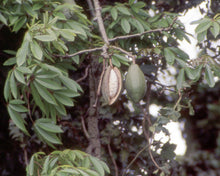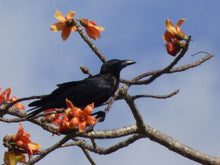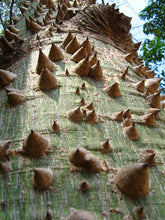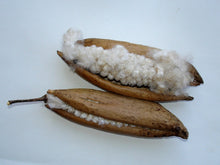Ceiba
Regular price
$5.00
Sale
Ceiba pentandra
Origin: Honduras
Improvement status: Cultivated wild material
Seeds per packet: ~10
Germination tested 10/2025: 57%
Life cycle: Annual
Pronounced "SAY-buh", and also called kapok, Java cotton, Java kapok, silk-cotton, or samauma, the legendary ceiba is tropical tree that's also one of the largest members of the mallow-family (which includes much smaller plants like hibiscus, cotton, and okra). It grows very tall, and sometimes the lower portions of the tree can grow as large as a house. Native to Central America and northern South America, it has become widespread through the tropics — often spread by people, but also, it's believed, by floating across the ocean in its buoyant pods. This is an important plant to dozens of cultures, as the many names listed below demonstrate. Ceiba has myriad uses including food (edible seed oil and floral nectar), medicine (diuretic, aphrodisiac, for headaches, and type II diabetes), lumber (light construction, paper pulp, plywood, rafts & canoes), art (such as the carved wooden masks of the Bobo and Mossi people of Burkina Faso), fiber, life vests, etc.
The soft filament-like fibers in the seed pods are the primary product of this tree. These fibers are light, resilient, water resistant, very buoyant, but unfortunately also quite flammable. It was formerly used by the ton in the manufacture of early life jackets and other flotation devices until it was replaced with synthetic materials. It isn't readily spun into yarn, like cotton fibers, so it is used mainly as a raw material much like down for applications like filling pillows, mattresses, upholstery, insulation, and even stuffed teddy bears. According to Wikipedia, native peoples along the Amazon River "harvest the fiber to wrap around their blowgun darts. The fibers create a seal that allows the pressure to force the dart through the tube."
Ceiba trees are so useful and so magnificent — with their broad canopies, beautiful flowers, and enormous trunks dotted with large conical spikes — that many peoples around the world have come to regard them as sacred (as in Maya mythology), and often these beliefs come to surround individual trees. One such is "the Castle of the Devil" in Trinidad, which is said to contain a trapped demon named Bazil. In Jamaican lore, Spanish colonizers are said to have forced enslaved people to bury treasure under a tree before killing them, trapping their spirits inside the tree to guard to buried treasure. And as a much less somber example, a 400-year-old tree on the Puerto Rican island of Vieques (see main photo here) has become a symbol of strength and resilience in the face of slavery, domination, imperialism, and oppression. According to a Vieques community leader named Ardelle Ferrer Negretti, a co-founder of La Ceiba Community Project, the indigenous Taino of Puerto Rico considered the ceiba tree to be the daughter of YaYa, the all-powerful goddess.
Our seed was imported from Honduras by the good folks at Sheffield's Seed Company in Locke, NY.
GROWING NOTES: Ceiba trees are only hardy to USDA Zone 10, so on the US mainland they can only grow outdoors in south Florida, extreme south Texas, and a few places in southern California and southwestern Arizona, but they will grow just fine in Hawaii, Puerto Rico, the Virgin Islands, Guam, Samoa, and the Northern Marianas. In the rest of the country, they can only be grown as houseplants. Some people have grown some truly gorgeous bonsai trees with ceiba. Seed need no prolonged treatment to germinate, but they benefit from 48 hours of soaking in water first and germinate best at around 77 degrees F in constantly moist soil.
COMMON NAMES:
Chinese – Mumian - 木棉
Haitian Creole – Mapou
Spanish – Ceiba, lupuna (Peru)
Portuguese – Sumaúma (Portugal), samaúma (Brazil), mafumeira (Brazil), ocá (São Tomé and Príncipe), poilão (Guinea-Bissau and Portugal).
French – Fromager
Surinamese – Kankantrie
Hindi – Safed semal - सफ़ेद सेमल
Manipuri – মোৰেহ তেৰা - Moreh tera
Malayalam – Panji maram പഞ്ഞി മരം
Tamil – Ilavam இலவம்
Telugu – Tellaburaga
Tagalog/Filipino – Bulak or bulac
Marathi – Samali
Kannada – Dudi
Sanskrit – Kutashalmali
Bengali – শ্ৱেত সিমল - Shwet simul
Assamese – শিমলু - Simolu
Samoan – Vavae
Khmer – ផ្លែគរ
Sinhala – Kotta
Ashante, Twi and Fanteen – Onyãã, or onyina
Mandingo – Banã, bãnda (Dioula), bantã (Malinké), banti
Indonesian – Randu/kapuk randu
Odia – Semili tula
Yoruba – Araba
Malay – Kekabu
Thai — นุ่น
Vietnamese – Cây gòn
Yucatec Maya – Ya'axche (modern); yaxche (colonial/archaic)
NOTE: Due to limited supply, these seeds have not been germination tested with a test that meets legal standards, so we are selling them as botanical samples.
Photo credit: First photo is by Jay Sturner, downloaded under the Creative Commons Attribution 2.0 Generic license. The rest are in the public domain.










